|
The Boy's Own Paper, 1879–1967 | |
Sequence |
Volumes 1–5, 1879–83 |
Editor |
James Macaulay and George Andrew Hutchison, 1879–97 |
Publisher |
Religious Tract Society |
Printer |
R. K. Burt and Co. |
Price |
1d. |
Format |
Demy 4vo. |
Pages |
16 |
Frequency |
Weekly |
Circulation |
600,000 (1879), 400,000 (1900) |
Indexes |
All volumes: Index of Contents, List of Principal Contributors, List of Full-Page Illustrations |
Copies |
Leeds University Library |
Introduction | |
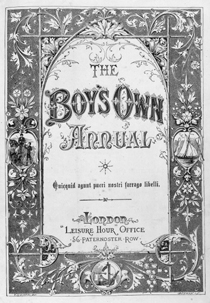 The Boy's Own Paper (hereafter BOP) was one of the most successful juvenile serials of the late-Victorian period and the longest running boys' periodical in Britain. It was much imitated by a plethora of boys' weeklies launched in the 1880s and 1890s but few enjoyed its wide circulation and longevity. Its success owed much to the fact that it 'appealed to the boys as well as to their parents', the latter relishing the mission of the periodical to lure male readers away from what they pejoratively called 'penny dreadfuls' (Dixon 1986, p. 137). The BOP originated in mid-1878 when members of the Religious Tract Society (RTS), a leading publisher of evangelical tracts and periodicals, began discussing the possibility of establishing a cheap and wholesome weekly alternative to the 'demoralising serials now so widely disseminated' and for which thousands of boys clamoured each week (Anon 1879). The RTS was expressing a concern shared by many middle-class parents, clergymen, teachers, and educationists, that the minds of children, and especially boys in their mid-teens to early twenties, were being corrupted by 'penny dreadfuls', cheap and astonishingly popular serials offering sensational stories of adventure and crime, spiced with a welter of crude illustrations. The RTS was not original in launching a cheap illustrated magazine to disarm this threat. By the 1850s falling costs of producing serials, rising juvenile literacy, and growing middle-class incomes prompted a boom in children's literature (Drotner 1988), and publishers capitalised on this by launching cheap weekly papers and expensive monthly magazines explicitly designed to draw children away from 'penny dreadfuls' which themselves flourished in this period alongside other juvenile literature. Samuel Beeton's Boy's Own Magazine (founded 1855), W. H. G. Kingston's Magazine for Boys (founded 1859), Margaret Gatty's Aunt Judy's Magazine (founded 1866), and Edwin Brett's Boys of England (founded 1866) were among the more successful of these new serials. What principally distinguished them from earlier nineteenth-century journals for children was that they differentiated readers in terms of gender, age, class and religious denomination (Aunt Judy's Magazine, for example, was more suitable for girls than boys, while the penny Boys of England reached more working-class boys than any of the sixpence monthly magazines), and they offered more diverse genres and fewer articles on religious material. To entice children away from 'demoralising serials' they included an attractive mix of serialised fiction (a genre to which religious publishers of children's serials were traditionally hostile), poetry, coloured plates, puzzles, essays on history, sports and travel, instructional articles on such wholesome subjects as natural history, answers to correspondents, and musical scores.  This marked shift away from the drearier and heavily didactic religious magazines for children was also illustrated by the Leisure Hour, a hugely successful twopence family weekly first appearing in 1852. The Leisure Hour was also published by the RTS and illustrates the more general move in the 1840s by religious as well as secular publishers towards cheap literature containing secular material written with a Christian tone. The RTS achieved this in the Leisure Hour with the kind of variety copied by the dedicated children's magazines of the 1850s and 1860s: the journal contained only a smattering of religious material and promulgated its moral mission through fictional stories and biographies of the virtuous and wise, essays on wholesome recreations, and poetry, puzzles and illustrations. Indeed, the Leisure Hour reflected and helped define the broader literary genres that from the 1850s were considered appropriate for achieving a serial with a moral tone. One of the editors of the Leisure Hour was James Macaulay who, by the 1870s, had become the RTS's General Editor and was deeply involved in the Society's ongoing attempt to thwart 'demoralising serials' and to cater to a new and much larger juvenile population that, following the 1870 Education Act, were more impelled to read. Macaulay solicited a solution from George A. Hutchison, the editor of several evangelical and charitable journals, whose specimen periodical, christened the Boy's Own Paper, did not win the unanimous approval of the RTS General Committee. Its more conservative members worried that the proposed amount of fiction in the journal threatened the evangelical tone of the journal, while more progressive members agreed that if the periodical was to be a viable alternative to unwholesome serials then it had to contain some of the elements (notably fiction) that made the latter publications so attractive. As Patrick Dunae shows (Dunae 1976), the tone of the BOP continued to be a source of difficulty between on the one hand, Macaulay and Hutchison, and on the other hand, the RTS, even though the Society was happy to use the considerable profits made by the journal to finance other aspects of its business. In November 1878 Hutchison's latest draft of the BOP won the approval of the RTS. The RTS chose Macaulay rather than Hutchison as the journal's editor, principally because, as an established RTS figure, he was considered more trustworthy than his younger colleague. Nevertheless, Macaulay hired Hutchison as his sub-editor who then undertook most of the editorial work owing to Macaulay's burdensome commitments to other publishing ventures. Hutchison remained as unofficial editor until he succeeded Macaulay on the latter's death in 1897. 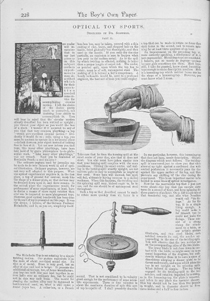 The form of the BOP for which Hutchison finally won RTS approval drew on aspects of the Leisure Hour and most other mid-Victorian boys' magazines, although the result differed from all these serials. It offered much more variety than the Leisure Hour: its larger format and three columns of text allowed for more fiction, poetry, essays on history, travel, warfare, and sport, and biographies, as well as genres absent from the older serial including instructional articles, colour plates, puzzles, replies to correspondents, appeals for charitable causes, music scores. It is equally instructive to compare the BOP with the Boys of England, one of the most successful boys' serials of the 1870s. The BOP matched the Boys of England for price, frequency of issue, and quantity of illustration but unlike the slightly older serial, the BOP offered more pedagogical material, biographies, and essays, and was in general less sensationalist in its text and illustrations. However, the BOP's stories and pictures of explorers' fights with wild beasts and similarly dramatic events put it much closer to the cheap boys' weeklies than the more sedate monthlies of the 1850s and 1860s. 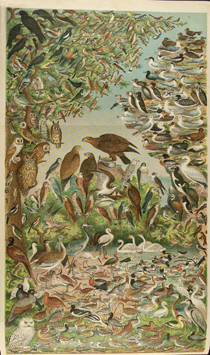 The BOP may have offered similar types of genres to those found in other juvenile serials of the 1870s, but it presented them to a generally higher standard. The print and paper quality of the journal, as well as the finish of the text and illustrations, set it apart from most other cheap boys' weeklies. Indeed, one of the keys to the long-term success of the BOP was the fact that it was graced by contributions from respected writers of boys' fiction, established popularisers of specialist subjects, and from expert practitioners of sport, exploration and other fields. It included tales by such well-known writers of adventure stories as Robert M. Ballantyne and Jules Verne, the scientific columns of the popular science writers John George Wood and John Scoffern, and first-hand accounts of sport and adventure by the likes of the cricketer W. G. Grace and the arctic explorer John P. Cheyne. Although the BOP was aimed at 'every boy in the land', the literary level of its texts and the kinds of subjects it covered suggested that its chief readership comprised teenage middle-class boys. Much of its fiction concerns the better schools and homes enjoyed by middle-class boys, while the material resources required to follow instructional articles were clearly beyond the pocket of most working-class youths (Anon. 1879). The BOP sustained its blend of entertainment and amusement well into the first decades of the twentieth century when it enjoyed a steady weekly circulation of approximately 400,000. In many ways, the RTS's resistance to changing the BOP's format in the fluid market of juvenile serials ultimately limited its growth. By 1897 the BOP was troubled by falling sales figures which translated as a sustained financial loss for the RTS. As Dunae explains (Dunae 1976), the BOP's declining fortunes owed much to the fact that the considerable production costs for this cheap high quality weekly exceeded its profits. The BOP allowed only a limited amount of space for advertising material and this made the journal financially weaker than the Captain (1899–1924) that boasted large advertising revenue. The Captain was one of many threats to the market position of the BOP in the 1890s. The myriad half-penny serials started by Alfred Harmsworth in the 1890s, aimed principally at lower middle-class boys, were cheaper to produce, more topical, and commanded larger circulation figures than the BOP. Elsewhere in the market, serials such as the Captain and Cassell's Chums (1892–1934) proved more successful than the BOP at catering to middle- to upper-class boys' interests in sport and news. What these new serials lacked, however, was internal patronage and it was the RTS's decision in the early 1900s to support the BOP from its own funds that helped this comparatively static and traditional journal to survive well into the twentieth century. | |
Notes on Indexing | |
Confusingly for most first-time readers, each year's run of the BOP was reissued in a single volume called The Boy's Own Annual. These ornately decorated tomes include an index, list of principal contributors and full-page illustrations, and a frontispiece that in tiny vignettes reinforces the mission of the periodical to combine instruction and entertainment. The following index is for the more comprehensive Boy's Own Annual because this is the form in which most users will find the periodical. Single and monthly issues of the BOP often turn up in antiquarian bookshops and these contain advertising wrappers that spectacularly illustrate the commodification of juvenile leisure and reinforce the assumption that the journal was primarily aimed at youths from wealthier families. 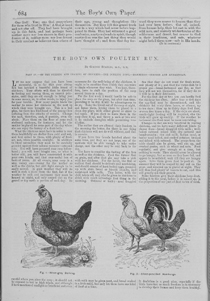 The index represents the first five volumes of the BOP which provides a substantial flavour of the workings of a late-Victorian juvenile serial. Many articles were anonymous or simply initialled but every attempt has been made to identify contributors. This task has been eased by the list of principal contributors included in the Boy's Own Annual. In many cases, contributors' signatures consisted of their name plus their title, and any additional information by which they sought to convinced readers of their authority on a given subject (for example, the journal added 'Joint Author of "The Naturalist's Note Book", etc.' to Theodore Wood's name). The full signature has been included in the index since this provides important information on the ways in which the credibility of popular science writers was constructed. Within a decade of its launch, the BOP contained one of the highest percentages (6 per cent) of scientific material in a broad range of leading non-scientific magazines published in Britain and America (Reed 1997, p. 257). Appearing at a time when the provision of scientific instruction in most British schools was decidedly poor, the BOP represents one of the major (and largely unstudied) sources from which late Victorian and Edwardians gained their early scientific education. Scientific material had featured, to one degree or another, in earlier juvenile serials and usually appeared as sources for rational amusement and wholesome instruction. Scientific material in the BOP was no different. Biographies of Michael Faraday, Robert Stephenson and other celebrated savants emphasised the triumph of industry, wisdom and piety over social and moral adversity; instructional articles on insects, electrical machines, and boats taught readers the basics of zoology, electromagnetism and fluid dynamics; articles on fireworks and optical tricks tied chemistry and physics firmly to the juvenile taste for spectacle; fictional stories of adventure in exotic lands promulgated theologies of nature and geographical facts, and replies to correspondents helped readers identify puzzling botanical specimens and good textbooks. The emphasis was typically on scientific topics that were believed to be more central to boys' hobbies and other interests. Accordingly, the sciences associated with collecting (botany and zoology), spectacle (chemistry and optics), machine construction (electricity and hydraulics), and exploration (geography and natural history), feature strongly and certainly more frequently than medical subjects. Indeed, medical topics typically appeared only in pedagogical articles on pet care and in stock fictional representations of physicians. Scientific material was also crucial to the BOP's strategy of sustaining existing readers and creating new ones. For example, serialised articles on optical toys enticed readers to purchase subsequent issues, while coloured plates and wood engravings of fish and machines bolstered the visual appeal of the whole journal. 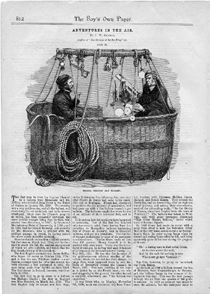 A high proportion of scientific material appears in serialised instructional articles, replies to correspondents, and short essays. As with other journals indexed for SciPer, it was decided to avoid or minimise descriptions for these types of articles because it was felt that their contents were adequately represented using the other standard components of the index. Some pedagogical articles warranted descriptions because they raised complex intellectual issues at the time and because they are of current historical relevance. A good example is John George Wood's series on 'On Killing, Setting, and Preserving Insects' (volume 1, 431–32) which denied that it was immoral to kill insects because such species 'cannot feel pain as we do'. This did not convince Hutchison who, keen to uphold the moral tone of the periodical, added a footnote to Wood's article warning that 'such facts do not diminish the guilt of wanton cruelty or the needless destruction of life' (volume 1, 431). Current interest in the representation of scientific practitioners justified the inclusion of lengthy descriptions for the BOP's biographies of natural philosophers and engineers, and for the periodical's more unusual fictional portrayals of similar practitioners. Thus, descriptions detail the way that the BOP reinvented Richard Arkwright to illustrate to readers how a boy, through 'patient industry' and 'courageous perseverance' can rise to greatness (volume 3, 157–58), and they explain Jules Verne's less favourable portrait of a bungling botanist (volume 2, 563–64). The BOP's 'Correspondence' columns typically comprised some twenty to thirty replies to correspondents identified by their first names. These represent some of the richest sources of scientific material in the BOP and while the index entries omit descriptions, users can glean the contents of replies to individual readers from the classifiers appearing within vertical lines in the 'Subjects' field. It is hoped that the bibliographical information in these entries will prove especially useful to historians of science, because it details the textbooks and other works being recommended to readers by the anonymous editor and team of scientific contributors. At a time of lacklustre scientific education in schools, such information shows the significant role played by juvenile serials in shaping the early scientific knowledge of the late Victorians and Edwardians. | |
Bibliography | |
Anon 1879. 'The Boy's Own Paper', Publisher's Circular, 42, 61. Cox, Jack 1982. Take a Cold Tub Sir! The Story of the Boy's Own Paper, Guildford: Lutterworth Press Dixon, Diana 1986. 'Children and the Press, 1866–1914', in The Press and English Society from the Seventeenth to Nineteenth Centuries, ed. by Michael Harris and Alan Lee, (Rutherford: Fairleigh Dickinson Press), 133–148 Dixon, Diana 2001. 'Children's Magazines and Science in the Nineteenth Century', Victorian Periodicals Review, 34, 228–38 Drotner, Kirsten 1988. English Children and their Magazines, 1751–1945, New Haven: Yale University Press Dunae, Patrick 1976. 'Boy's Own Paper: Origins and Editorial Policies', The Private Library, 9, 123–58 Hannabus, Stuart 1977. 'Information Clinic: The Correspondence Columns of the Boy's Own Paper', Library Review, 26, 279–85 Noakes, Richard 2004. 'The Boy's Own Paper and Late-Victorian Juvenile Magazines', in Science in the Nineteenth-Century Periodical: Reading the Magazine of Nature, by Geoffrey Cantor et al., Cambridge: Cambridge University Press, 91–122 Reed, David 1997. The Popular Magazine in Britain and the United States of America, 1880–1960, London: The British Library Warner, Philip 1976. The Best of British Pluck: The Boy's Own Paper London: Macdonald and Jane's | |
Richard Noakes | |
© Science in the Nineteenth-Century Periodical Project, Universities of Leeds and Sheffield, 2005 - 2020
Printed from Science in the Nineteenth-Century Periodical: An Electronic Index, v. 4.0, The Digital Humanities Institute <http://www.sciper.org> [accessed ]